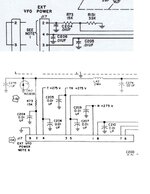neazoi
Advanced Member level 6
Hi, a Collins KWM2-A I service (1st schematic) does not have stabilized voltage on the VFO and during transmit (where more current is drawn and voltage gets lower) the frequency changes a bit. This is a known problem and fixed on later serial numbers with the zener circuit (2nd schematic).
I wonder if I can use exactly the same peripheral components and just replace the 150v 1W zener with a 0A2 gas regulator tube? (asumming I will find a way to mount it under the chassis).
Thanks
I wonder if I can use exactly the same peripheral components and just replace the 150v 1W zener with a 0A2 gas regulator tube? (asumming I will find a way to mount it under the chassis).
Thanks
